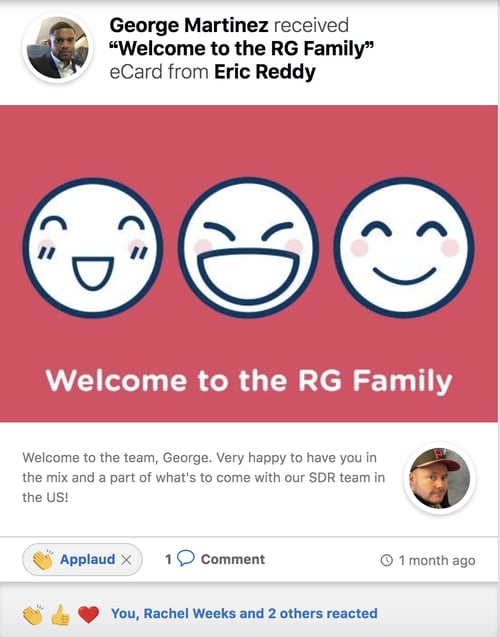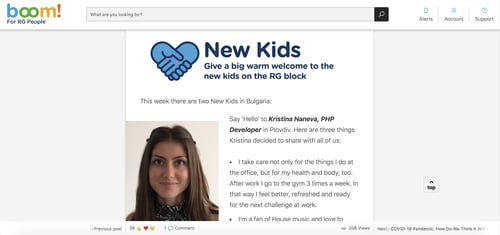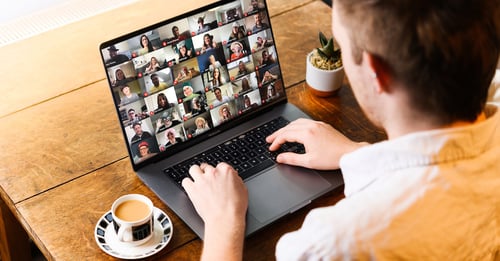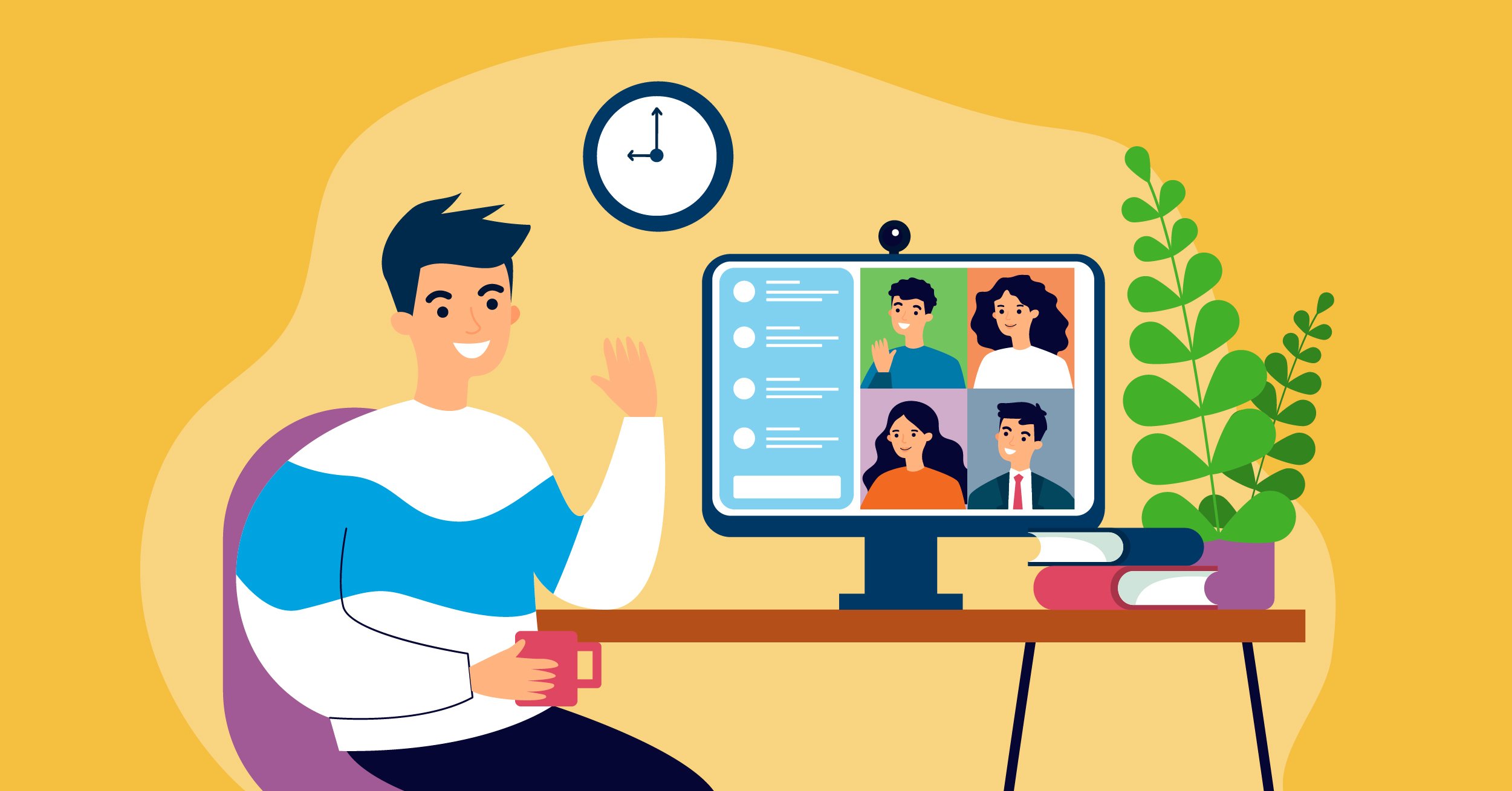6 min read
3 managers share their own team onboarding stories
Improving the employee experience while onboarding employees remotely can seem challenging at first and there's a whole new set of challenges that HR professionals and managers are facing.
After speaking with some of the managers at Reward Gateway about their own strategies, we’ve compiled some helpful tips to get you started on your journey.
In the first part of our series, we uncovered some tips for onboarding remote employees like embracing change or collaborating with various departments. This time around, we’re focusing on how to:
| 1. Personalise the journey |
| 2. Provide L&D opportunities |
| 3. Have some fun along the way |
1. Personalise the journey
Unsurprisingly, people learn and digest information in different ways and no two onboarding journeys should look the same. As a manager, take the time to set up virtual calls with your new hires to understand their preferences, learning style and personality traits to get a better understanding of how to best personalise the experience. This will also give you insight for how to recognise remote employees on your team.
| Name: | Eric Reddy |
| Role: | Head of Sales Development |
| Location: | United States |
Having a defined schedule for new hires during the first two weeks is key. We tailored the onboarding schedule and meetings with new colleagues so that the new hire was learning about aspects of the business and meeting key stakeholders tied to those learnings at the same time. This allowed for specific questions to be answered more easily and tips/tricks could be shared early in the learning process.
Another key piece of personalising the journey is to celebrate wins in their first few weeks.

On the flip side, if they struggle with certain learnings, see if maybe a different voice is needed as that could make all the difference with someone understanding something new. It’s all about doing what’s best for the individual, and affirming and reaffirming to the new hire that it’s going to take time for them to get up-to-speed with their more experienced colleagues.
Download our eBook to discover tips for onboarding remote employees during COVID-19 »
Takeaway: Let your new starters know that it’s ok to ask lots of questions. Being inquisitive and curious will only help them learn and progress, especially as we navigate these uncertain times. Set clear expectations, be understanding and provide the right tools.
| Name: | Rebecca Poxon |
| Role: | Client Success Team Manager |
| Location: | United Kingdom |
In addition to video calls with the entire team, we did a few things that we normally do during induction, like our buddy-up system – an ongoing initiative where our Client Success Managers (CSMs) are paired up to support one another and check-in regularly.
We wanted to improve social connections even while working remotely, so we created weekly team quizzes that the new starter could join, in addition to joining meetings with clients and listening to calls.
Depending on the individual, personalise sending something to their home address to make them feel included. Or take a more relaxed approach to the induction by getting to know the individual. Have one-on-one time so they feel you’re there to support, whether that's a coffee date, “get to know you” or a team lunch.
Takeaway: Focus on fun, personalised activities with the team to encourage relationship building.
2. Provide L&D opportunities
With our employees all working from home, there’s an innate desire for more learning and development or professional development opportunities. This is especially true for new hires, who want to learn more about the organisation they just joined and the people who work there. Take the time to make sure your people have the information they need at their fingertips.
| Name: | Didi Kirova |
| Role: | Head of Learning |
| Location: | Bulgaria |
Before someone starts with us, we make sure to ask some information about them, such as their favourite snack or food, favourite hobby, and favourite song, and this information is then passed on to the hiring manager. This not only helps them get to know the person, but gives some great welcoming gift ideas.
Plus, the L&D team makes sure to reach out to every hiring manager before their new starters' first day to offer help and guidance. Getting to know your colleagues from the get-go creates a strong and long-lasting foundation for the future. Another way we introduce new starters is with our weekly People News on our employee engagement platform, boom!. Everyone in the company has visibility to the blogs and can even comment or add reactions as a way to say welcome to the team.

We also reach out to new starters to not only provide the usual onboarding L&D session to take them through our learning tools, but to make sure they’re enjoying learning and finding what they need. This was done by the rest of the team as well, who take our new starters through our benefits, internal communications tools and people tools.
The People Team is making sure we’re even more visible than before.
Takeaway: The learning doesn’t stop at onboarding – it’s important for employees to stay connected to their team and managers and continue learning at the organisation. As a manager, be sure to reach out often and ask how things are going, offer help and guidance where needed and adapt all processes to work online.
3. Have some fun along the way
The everyday office antics may be on hold right now, but RGers across the world are still finding ways to bring some fun into new hire’s days. When managers embrace playfulness and encourage new hires to join in, you can sustain company culture even while working remotely and give your people the connection they’re looking for.
Try hosting a Friday afternoon trivia session, doing a virtual scavenger hunt or asking people to share what they’re cooking at home.
| Name: | Becs Thomas |
| Role: | Client Success Team Manager |
| Location: | United Kingdom |
We had a new starter join the team a few weeks before we introduced WFH for the UK teams. We typically meet once a week for a team meeting, but we're now meeting every morning as a way to kick off the day and share what's on our to-do list for that day. We’ve tried to keep the fun levels up by hosting a “social” event every Friday afternoon – we’ve done a quiz and we've done an Easter egg hunt.
This week, our new hire introduced the team to “Taskmaster” a series of funny and simple tasks to video and share with the team. And we’ve held our first-ever remote kick-off meeting (including a successful Bake-along!).

We're sharing a little more than usual about our personal lives, like what we’re eating for lunch, how we spend our evenings, what we do for our daily exercise and even new hobbies. I also feel like I know more about everyone's family and feel more connected to them on a personal level than ever before!
It's important right now that we try our best, no one has operated like this before, we are all guessing, so we might get things right, and some things wrong.
But the more we are open with our teams and colleagues and show our vulnerabilities we can build trust, create a good culture and keep remote employees engaged, which we can continue when things go back to normal!
Takeaway: My advice? Be open and honest and BE HUMAN, we're all in this together so be inclusive where you can.
No matter where you are on your journey to improving your remote onboarding strategy and strengthening the employee experience, remember that the most important piece is supporting your people. There’s no such thing as “getting it right on the first try.”
Adapt, listen, gather feedback and celebrate the milestones along the way.
I’d love to hear more about your current initiatives and how you’re reaching your people. Send me a message on LinkedIn and stay tuned for the next part of our remote onboarding series where we get an insider glimpse into employees’ perspectives.
 Carla Sutherland
Carla Sutherland
